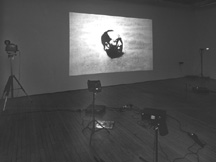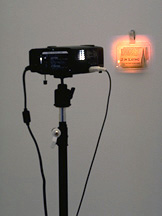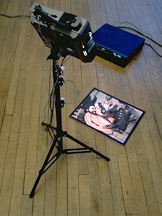- MAIN INDEX | ARTIST INDEX
| January 12 - February 18, 1995 Doug Ischar
| |
 Doug Ischar, installation view of "Wake", 1995. Photo Peter MacCallum. 18K | |
 Doug Ischar, "Pass", hand written note, name tag holder, newspaper clipping, 1995. Photo Peter MacCallum. 18K |  Doug Ischar, "Cul de Sac", contour map of S.E. Asia, "Lighting for Television, found footage - Che Gueverra, Academy Leader, 1995. Photo Peter MacCallum. 18K |
| Media Release Doug Ischar's Wake is a multimedia installation that includes film projections, video, found text, photographs and objects . "In Wake, boys lead on to desires through an alluring quick turn of a head or an antagonistic two-handed gesture that barks "come only," as the lead of a film reel is suspended in its countdown and recycles 6,6,6,6... reversed and inverted... onto the image-corpse of a shirtless and unzipped Che Guevarra and suburban dreams are projected onto Asian beaches". -- John Paul Ricco Ficto-critical lesbian writer Catherine Lord will give a reading of new work in conjunction with this exhibition on Saturday January 14th at 3:00 at Mercer Union. Lord will be writing a critical text on Wake for an upcoming exhibition of the installation in Chicago. Doug Ischar is a Chicago based artist. He is currently part of the Graduate faculty of the University of Illinois. His work deals with issues surrounding gay identity, private pleasure and public scrutiny --topics which he has also written and spoken extensively. He is currently exhibiting at the National Gallery in Ottawa in disrupted Boarders. This is his first exhibition in Toronto. A brochure with text by John Paul Ricco has been produced in conjunction with this exhibition.
A telling critique of mass media
Kate Taylor THE main gallery space at Mercer Union's new head quarters at King and Spadina is, dominated these days by a large projected image of Mao Tse Tung's head bobbing in the sea. The famous news photo of the Chinese leader swimming presented a massive and propagandistic diffusion of what would normally be a semi-private act. As Mao glows, a half dozen other film and video projections scattered around the gallery flicker and buzz, all addressing themselves to similar themes in this smart installation, entitled Wake, by Chicago artist Doug Ischar. Cul de Sac , for example, combines a news photo of Che Guevara's corpse and a contour map of South east Asia with found film footage of a beach and a backyard, and another projection showing a man in swimming trunks undoing his fly. In Tag, a tiny projection uses the collar of a white shirt as it's screen. The image -- an old movie scene of a man wrestling a crocodile -- just fills the area where the shirt's label would usually be sewn. The joke is that the shirt is Lacoste, so that the projected alligator is replacing the embroidered one. Pass shines a light onto the plastic holder for an ID card which contains a fragment of a newspaper clipping. Its partial headline says "IN SLAYING" while the type underneath asserts "in any case Safian was not a homosexual." These juxtapositions of the global and the personal, the political and the domestic, the violent and the mundane suggest subtle and not-so subtle invasions of privacy. Ischar has often addressed gay themes in his work, and his concern in these pieces with the relationship between the public and the private relates to that, but his project is also a universal one. Wake is a telling critique of mass media's long march. The rest of the gallery has been given over to members of the Toronto collective Brown Spot, who have mounted a smart-ass if not particularly original show about art as commodity. It includes a wall of objects for sale -- buckets with holes in them, toques with the group's name and a flacon containing "John's soul," cheap at 99c.
| |